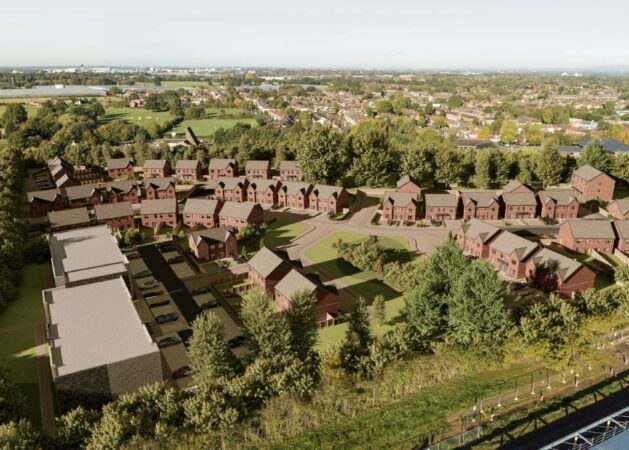IN FOCUS | Gove scraps 300,000 homes target
The decision to cave to backbench pressure and dilute local authority housing targets will do little to alleviate the housing crisis and demonstrates the government’s fragility, according to consultants in the region.
Despite reaffirming its commitment to deliver 300,000 homes a year as recently as October, the government has now rowed back on the policy amid mounting pressure from backbench MPs.
The government has also diluted local authority planning targets.
The figure that sets out how many houses should be built per year in any given borough will remain but will be considered “a starting point with new flexibilities to reflect local circumstances”, according to the Department for Levelling Up, Housing, and Communities.
Purely political
Sean Fielding, account director at communications consultancy Becg, said that the decision doesn’t change a great deal but sends a clear message to MPs.
“Technically, nothing has really changed. The standard methodology was always a starting point for determining housing need.
“The message it sends to Conservative backbenchers and councillors up and down the country is that it is safer to court the votes of those already on the housing ladder than those aspiring to own their own home.”
Fielding added: “With only two years before the next General Election, Rishi Sunak simply doesn’t have the political capital to push through meaningful planning reform.”
Anna Relph, director at Turley, said she was not surprised by the announcement and agreed that it does not deviate wildly from the current National Planning Policy Framework, which she explained: “already enables local planning authorities to progress with an alternative method in exceptional circumstances”.
“In reality, these [local housing] targets have never been mandatory,” Relph said. “What is being suggested now is, at most, a slight change in language to try to appease Tory backbenchers.
Gillian Worden, director at P4 Planning agreed that the changes were further evidence of the politicising of the planning system.
“It’s political pandering to rebels calling for their NIMBYism to be enshrined in law,” she said.

Sunak “doesn’t have the political capital to push through meaningful planning reform”, Fielding said. Credit: HM Treasury, CC BY-NC-ND 2.0 bit.ly/3tAFsmV
Signs of weakness
Labour had agreed to back the government’s original planning reform bill, which proposed leaving housing targets alone.
Forging ahead with this plan would have weakened the Conservatives’ position ahead of the next general election, according to Paul Boyfield, group property director at Lexington.
“The government did not want to cave on this, but relying on Labour’s offer of support to get its flagship legislation through the Commons would have made Rishi Sunak look extremely weak. Not a great way to make policy.”
The election outlook
Boyfield predicts that the move could benefit the Tories in the long run as it tries to hold on to its majority.
“Conservative MPs, including those with quite large majorities, are now panicking about losing their seats,” he said.
“They feel vulnerable to Lib Dem challengers across the home counties on this issue and they hope this move will limit some of the damage from what is increasingly looking like a wipe-out at the next general election.”
Fielding expects planning reform to play a starring role in the political discourse ahead of the next election.
“With the Labour Party speaking out in defence of national housing targets and the need to tackle the housing crisis, planning reform is a sore that I expect to be picked, especially across so-called Red Wall seats.”
Planning by appeal?
Nick Lee, managing director at NJL Consulting said the decision to scrap housing targets is a departure for the Conservatives and warned of the impact of the decision.
“The Tories used to compete to offer more homes and greater home ownership. This decision further shows they have lost their way on this issue.
“We need targets. The city region or regional level approach to this needs to be reintroduced urgently to make it more effective. Until then, the system will continue to fail and planning by appeal will rise.”
- Subplot explored the potential implications of the planning reforms on the appeal process last week.
P4’s Worden is concerned that the reforms will mean developers will have less chance of overturning the refusal of housing schemes at appeal.
“Taking away the teeth of the Planning Inspectorate could seriously undermine the planning system,” she said.
“Getting rid of the ‘tilted balance’, which kicks in when a local authority has a significant undersupply of housing, may have huge implications for the prospects of success for housing proposals at appeal.
Gove’s view
Levelling Up Secretary Michael Gove recognised that there is an “urgent need in this country to build more homes” but said that “new development must have the support of local communities”.
“That requires people to know it will be beautiful, accompanied by the right infrastructure, approved democratically, that it will enhance the environment and create proper neighbourhoods,” Gove said.
“These principles have always been key to our reforms and we are now going further by strengthening our commitment to build the right homes in the right places and put local people at the heart of decision-making.”
Who will be affected?
While consultants wait for detail on how the planning system will look once the proposed changes are hardened up in policy, Turley’s Relph admitted it is difficult to see past local authorities “seeking to progress lower housing requirements within their local plans”.
“This will do very little to address the chronic shortage of housing in this country,” she said, adding that the changes in policy are “quite contrary” to the government’s stated ambition of getting more young people on the housing ladder.
“The mantra from government focuses on putting local people at the heart of plan-making. In reality, this ambition is juxtaposed with delivering the level of housing that is needed within this country.”
Nick Graham, planning director at Peel L&P was firm in his view that little good could come from the proposed reforms.
“Many people are likely to be badly affected by the changes announced today, younger, and disadvantaged people most of all.
“This could result in far fewer homes being built, making the current and growing housing crisis much worse, also widening the gap between rich and poor, and weakening the economic growth we desperately need.”






Easier to say they met housing targets when they don’t have one.
By Anonymous
The Conservatives not sticking to their manifesto promises? My goodness what kind of topsy turvy world is this
By Anonymous
What does this mean if developments go to appeal, can they no longer rely on the 5 year land supply argument?
By Rich X
Shame they couldn’t have shown the same ‘care’ with other (more important) issues over the last 3 years
By FTT
@Rich….I think this may mean that councils may be more confident in refusing planning applications in general as “need” would not be an argument anymore…can anyone clarify?
By Anon
“Putting local people at the heart of plan-making” is not really the answer, as quite often they have no idea about design and aesthtics, and also local people might not think like people who want to come into a community. In Liverpool many of the councillors have shown themselves to be anti-development and change, and in many cases the design standards of homes have been very low, and way below the level of the housing being replaced when the main problem had been neglect and poor maintenance.
By Anonymous
We as a nation have never built 300,000 houses pa since the sixties. And that was a time when they were still clearing slums.
The argument should be what type of houses. We’ve built more houses per annum than household formation since 1996, yet House prices and mortgage affordability (in certain regions specifically) have shot up by several percentage points. It’s mortgage availability we should be looking at.
By SW
Those asking about 5 year land supply / need – the 5yls that has to be delivered is based on the government’s housing number or the target set out in the local plan so long as the local plan is up to date. If the local plan succeeds in setting a target lower than LHN and the council is meeting/exceeding that target then there would be no 5yls argument.
By Martin Cranmer
We have yet to see how much of this actually changes policy as opposed to being the right mood music to satisfy MPs. Worth remembering who pays a lot to fund political parties in this country which is why any attempt to impose more on housebuilders is pretty certain to fail.
By Informed planner
At some point the Conservative Party are going to remember who funds them.
By the light of the moon
The fundamental problem is that most developers have no interest in building “beautiful” homes, as is clearly shown by the banal, mass-produced, repetitive rubbish shown in the illustration in this article. Unless and until, developers are forced to raise their game, communities will oppose almost all of their proposals. I’m not the biggest fan of HRH, but his housing schemes at least show some respect for local communities.
By Anonymous
Party before the country, always the way with the tories.
By Anonymous
Simple …lot less housing starts …NIMBYs will pressure councillors who cos of short term electoral gain will stop development. Councillors often hide behind national targets as they have gone …they will simply give in to pressure. …conservative government have put party before country
By George
The industry is propping itself up on the common delusion that building more homes will solve the housing crisis. The commodification of housing is a big, complex issue; churning out as many homes as possible has not and will not solve it.
This shouldn’t be about votes and enabling NIMBYs – but we SHOULD think hard about the kind of communities we’re building and the value of green space in and around our cities. There is no question to which cul-de-sacs of low-density, high-carbon, two-car Dursley homes are a good answer.
By W
All houses should be at least 3 storey, anything less should be in a block as a maisonette or a flat, we need to make the best use of urban land as possible and get value for money.
In this way we can help preserve as much green-belt as possible and provide more rooms, as many people would desire more internal space rather than an outside garden , meanwhile parking cars should be in an undercroft.
By Anonymous
Time to vote Labour
By John Smith